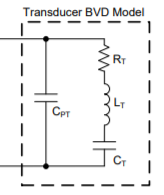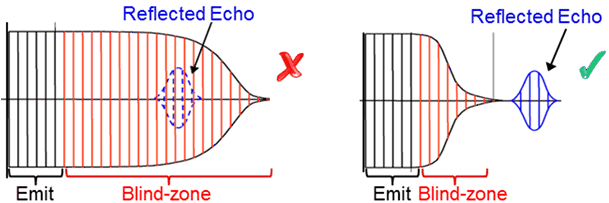SLDA058 March 2021 TUSS4470
- Trademarks
- 1Review of Ultrasonic Sensing Range Performance Factors
- 2Methods Overview
- 3Short Range Air-Coupled Test Results
- 4Mid-Range Air-Coupled Test Results
- 5Short Range Water-Coupled Test Results
- 6Resistive Damping Device Comparison
- 7Summary
- 8References
- A Appendix A
- B Appendix B
1.2 Transducer Characteristics
A transducer's diameter, mechanical packaging and quality factor also have a measurable impact on transmission range. In one common definition, the quality factor of a mechanical-electrical oscillator is proportional to the reciprocal of its resonant half power bandwidth. The Q-factor can be described similarly by the ratio of energy stored to energy dissipated per cycle of the oscillation. For example, a perfect transducer would have an infinitely narrow bandwidth and an infinite Q-factor, and the BVD model of this theoretical transducer is a lossless LC oscillator. Thus, a transducer with a higher Q-factor will have a longer oscillation decay than a transducer with a lower Q-factor
The damping of a commercial transducer is related to the resistance of the BVD model (RLC circuit). The BVD model's damping resistance corresponds to the overall damping characteristic of the transducer, which is a function of the transducer packaging, such as the enclosure and backing material surrounding the piezo element, as well as trace electrical resistance.
 Figure 1-3 Transducer BVD Model
Figure 1-3 Transducer BVD ModelThe ring down period of a transducer is the length of time that the transmit signal takes to decay, also known as the blind-zone in reference to a plotted signal. The reflected ultrasonic pulse cannot be received within the ring down period. One method for reducing the ring down time is to increase the resistance of the RLC model of the transducer by mechanical or electrical means (utilizing mechanical damping or a parallel damping resistor).
 Figure 1-4 Monostatic Ring Decay
Figure 1-4 Monostatic Ring Decay